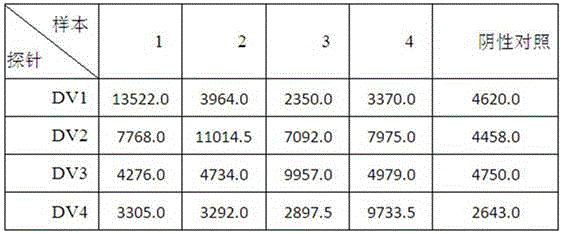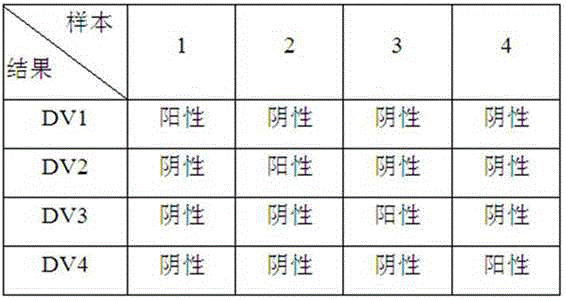Primers, probes and methods for detecting dengue virus and its typing
A technology of dengue virus and dengue, which is applied in the field of biochemistry and biological detection, can solve the problems of inability to realize early diagnosis of cases, complex detection condition setting, low specificity and sensitivity, and achieve fast detection speed, stable results, The effect of rapid typing test
- Summary
- Abstract
- Description
- Claims
- Application Information
AI Technical Summary
Problems solved by technology
Method used
Image
Examples
Embodiment 1
[0038] Embodiment 1: Design and synthesis of primers and probe sequences
[0039] Search the sequence of dengue virus target gene nonstructural protein NS5 from Genebank, use relevant bioinformatics software for homology analysis and sequence comparison analysis, screen out highly conserved regions, and use primer design software PrimerPremier5 for conserved sequences to design primers and probes Design; after the design of primers and probes, use NCBIBLAST to test the specificity, and use Primerpremier5 to detect whether there is a hairpin structure or dimer formation. The results show that the designed probe meets the specificity requirements and will not form a hairpin structure or dimer. The designed primers and probe sequences are listed in Table 1.
[0040] Table 1 Primers and probes for detecting dengue virus and its typing
[0041] name
Embodiment 2
[0042] Embodiment 2. Preparation of four kinds of serotype dengue virus-specific probe microsphere groups
[0043] 1. Probe synthesis
[0044] Various probe sequences were synthesized according to SEQ ID No: 13-16 in Table 1, and the 5' ends of all probes were modified by amination and connected to the C12 adjacent arm sequence.
[0045] 2. Coupling of probes and microspheres
[0046] Randomly select 4 different fluorescent microspheres. In this embodiment, the numbers of the selected fluorescent microspheres are 18, 30, 36, and 42. The coupling of the probe and the microspheres is carried out according to the following method:
[0047] 1. Put the 4 microsphere suspensions numbered 18, 30, 36, and 42 stored at 2-10°C and 2 bottles of unopened EDC powder (10mg / bottle) stored at -20°C at room temperature for 30- 60 minutes;
[0048] 2. Use ddH 2 O dissolved, the concentration is 0.1nmol / μl;
[0049] 3. Vortex the microsphere suspension at high speed for 30 seconds, then ult...
Embodiment 3
[0072] Embodiment 3: to the detection of 4 dengue virus clinical samples
[0073] 1. Sample preparation
[0074] The total RNA of No. 1-4 clinical samples was extracted by conventional methods, and the concentration was measured for future use. The clinical samples were serum or mosquitoes. In this embodiment, human serum was selected as the sample to be tested.
[0075] 2. Reverse transcription reaction
[0076] 1. Synthesize various reverse transcription primers according to SEQ ID No: 1-4 in Table 1.
[0077] 2. Prepare mixed reverse transcription primer working solution:
[0078] 1) Prepare each synthesized reverse transcription primer with TE (pH8.0) to prepare a 100 μmol / L stock solution;
[0079] 2) Add 10 μl of each reverse transcription primer storage solution to the same 1.5ml Eppendorf tube, add 460 μl TE (pH 8.0) to make up to a total volume of 500 μl, shake and mix well, and it is the mixed reverse transcription primer working solution.
[0080] 3. Sample tota...
PUM
| Property | Measurement | Unit |
|---|---|---|
| diameter | aaaaa | aaaaa |
Abstract
Description
Claims
Application Information
 Login to View More
Login to View More - R&D
- Intellectual Property
- Life Sciences
- Materials
- Tech Scout
- Unparalleled Data Quality
- Higher Quality Content
- 60% Fewer Hallucinations
Browse by: Latest US Patents, China's latest patents, Technical Efficacy Thesaurus, Application Domain, Technology Topic, Popular Technical Reports.
© 2025 PatSnap. All rights reserved.Legal|Privacy policy|Modern Slavery Act Transparency Statement|Sitemap|About US| Contact US: help@patsnap.com


